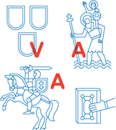VAA VF ADL Restoration Laboratory. Room No. 125, Maironio str. 6
Students are provided with the conditions to perform all technological processes in the
Restoration Laboratory:
- easel painting and wood polychromy;
- wall painting;
- sculpture conservation and restoration;
- some physico-chemical researchs of artworks.
This equipment is located in the created workplaces:
- UV lamp with magnifying glass;
- Electric spatula with warm air blower;
- Electric spatula CTS Artist III;
- Multifunctional grinding, engraving, cutting tool;
- Multifunctional accumulator vibro-grinding-cutting device Bosch GPO 10.8V Professional;
- Dino-Lite digital microscope;
- Laboratory scales KERN;
- Work tables with dust extraction (in the wall painting and sculpture restoration rooms);
- Fume cabinet (in the chemistry laboratory);
- Portable sandblaster with air compressor;
- Mobile workbenches for woodwork Bosch PWB660;
- LED daylight mobile lamp Harolux LED 19,200 lm, 5700 K;
- Modular stereo microscope SMZ 171 with camera and software (trinocular head, segmented LED ring illumination system, camera with software Moticam 6, stand witharticulated arm);
- Modular stereo microscope SMZ 171 with binocular head, segmented LED ring lighting system and universal stand on a stable base;
- Vacuum cleaner Muntz Museum Vacuum Cleaner 555 MU E with HEPA filter;
- Ultrasonic scalpel SonoCraft ST-360 with accessories;
- Heating lamp Speedheater Cobra (for removing paint);
- Small equipment and work tools (for studies of art objects, works for conservationrestoration and technological processes).
Up to 14 students can work at a time in the Restoration laboratory workspaces.
___
Students working in the Restoration laboratory are provided with equipment and tools for various technological processes as described in the presentation of the laboratory's capabilities.
All materials and tools necessary for the technological processes are provided to students in the laboratory, while lecturers are provided with what is necessary for their work functions.
Students have access to various necessary materials for conservation and restoration of the art works (according to the presented coordinated need of the Department for the annual budget):
- Various solvents;
- Various glues of protein origin (skin and bone glue, gelatin, casein);
- Antiseptics;
- Various polymers;
- Natural resins (shellac, damara, rosin, mastic);
- Inorganic natural and synthesized pigments;
- Various acrylic and watercolor paints;
- Scraps of linen fabrics, canvas;
- Paper (filter, mycolent, papyrus);
- Cardboard;
- Sand of various fractions;
- Gypsum;
- Chalk.
Students are only partially supplied with materials when carrying out their personal projects of the conservation and restoration (according to point 6 of the "Work Rules of Restoration Laboratory" approved Rector‘s order No. VĮU-47, dated 2016-09-01).
If you have any questions, please contact the responsible head of the Restoration laboratory by e-mail or phone, indicated in the contacts of the Restoration laboratory.




